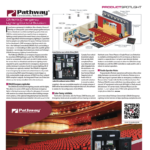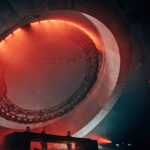When the editor of PLSN asked me if I would be interested in writing a review for the new Chauvet QWash LED, my mind raced back to my days backstage, when my crew and I would take advantage of slow moments between shows to give our flashlights the Pepsi Challenge. I would pit my Mag-Lite against anyone else’s flashlight to see which was stronger and at what distances. On one occasion, a board op came up with his LED flashlight, swearing that his could finally dethrone the hoss, and it did…at short range. But the Mag stood strong at longer distances, such as from the floor to the grid 60 feet above. Even at that distance, I could easily make out the details in the cables suspending the rigging. His LED didn’t even provide a light pool at that range.
When I first received the Q-Wash, I thought of that incident, and my first thought was, “Ah, another LED that works great at close range, but loses the long throw to inherent diffusion.” Upon actually operating the fixture, one immutable fact confronted me head-on: Times change.
The Gear
The Chauvet Q-Wash LED is a wash fixture that uses 18 one-watt LEDs equally divided between red, blue and green for an RGB color palette. It is a moving head fixture with 540 degrees of pan and 270 degrees of tilt. The yoke consists of one arm, as opposed to the usual two, which is plenty to sustain the small moving head.
The fixture accepts DMX512 signal via a 3-pin XLR input and is capable of daisychaining to other fixtures. It can be operated as a solo device, in a master-slave daisychain (in which up to 32 units can be linked) or from a console. When in DMX mode, it uses a 10-channel footprint. Addressing, mode selection, etc. are completed using a push-button panel on the base. Also found on the base are power input, the fuse, the fixture’s microphone for cueing off of sound and a switch that selects either American or European power standard.
The fixture is designed to be mounted either upside down (in a truss or from a grid) or floor-mounted upright. Chauvet literature also indicates that the unit can be mounted sideways from any flat surface using a bracket, but I confess that I didn’t try this.
That’s a fair rundown of what you’ll see when you open the box, but let’s look at how the gear performs.
Performance
First and foremost, the fixture annihilated my memories of Pepsi Challenges with the old Mag-Lite. Whether red, blue, green or in combination, the fixture shoots a fairly solid 30-degree beam, and I personally tested it at ranges up to 40 feet. I’m pretty sure that it could throw farther.
With its adjustable fan speeds, you can reduce the decibels put out by the cooling system (always a plus). That said, the fixture does seem to lend itself to applications where there will be some modicum of sound in use on a consistent basis. The yoke and head are not loud by any means, but they are audible during quiet moments, as in a production of any dramatic play that involves a lot of silence. Of course, this becomes more of a fact the faster the unit pans, as the pan is far louder than the tilt.
The accuracy of the pan and tilt cannot be denied, however. As a test, I programmed chases in which the hot spot focused on a specific object or mark that was never more than six inches across and at least 20 feet away from the unit. In any step with two seconds or more, the unit never missed, no matter how many times I ran the chase. I only got the fixture to finally miss a mark by speed testing it with longer and longer pans. The unit finally didn’t make a mark when I programmed a step that required a 270-degree pan in one second with a .5-second delay to the next step. The pan did not finish before the next step took over, but do not let this deter you, as I was running it to the brink to find out where the brink was.
In terms of behavior while programming, the fixture responds very well to commands, and its console-adjustable vector speed means that, should you not be pleased with the speed at which the unit moves during programming, you can adjust its response time. I never got it to respond to my wheel commands movefor- move in real-time, but I was able to adjust the vector speed to a point where it kept up well.
The star of the show, however, is color control. The rest of this is pretty much par for the course in Fixtureville, but this fixture accomplished one thing that I have not seen in a while: true white from a single fixture. Despite a lack of any white LEDs, or maybe because of the lack, the Q-Wash LED can create the closest thing to a true white that I have seen in years. Where halogen and arc sources have an amber or blue hue, respectively, the RGB mixing in the Q-Wash LED created a white in which I detected no color temperature variations warmer or cooler. It takes a bit of manipulation to get the perfect blend, but it’s there to be had. The pure red beam looks more like a flame than a true red, but I suspect that this was done to introduce a wider spectrum for color mixing, whether to achieve white, yellow or any secondary/tertiary color. In addition, the color variations on the Q-Wash can be achieved in nearly zero time. No matter where on the palette a color lives, the Q-Wash LED can make it faster than flags, wheels or halogen start-up. Its blackout time is equally fast.
Conclusion
With a small footprint of 10 DMX channels and one-watt-per-LED power consumption, and with the aforementioned performance factors, the Chauvet Q-Wash LED would serve very well on any show that required precision color mixing as its primary concern. I cannot, however, vouch for long throws of 50 feet or more, but if someone told me that they were possible, I would believe them.
For those of us who have struggled with the encroachment of LEDs into our beloved halogen or arc landscape, I think it’s time we pull our heads out of the sand for a minute. This fixture met or outperformed my every expectation and proved to me that, not only are the times changing, but LEDs are one of the things changing them. I think my flashlight just got depressed.


